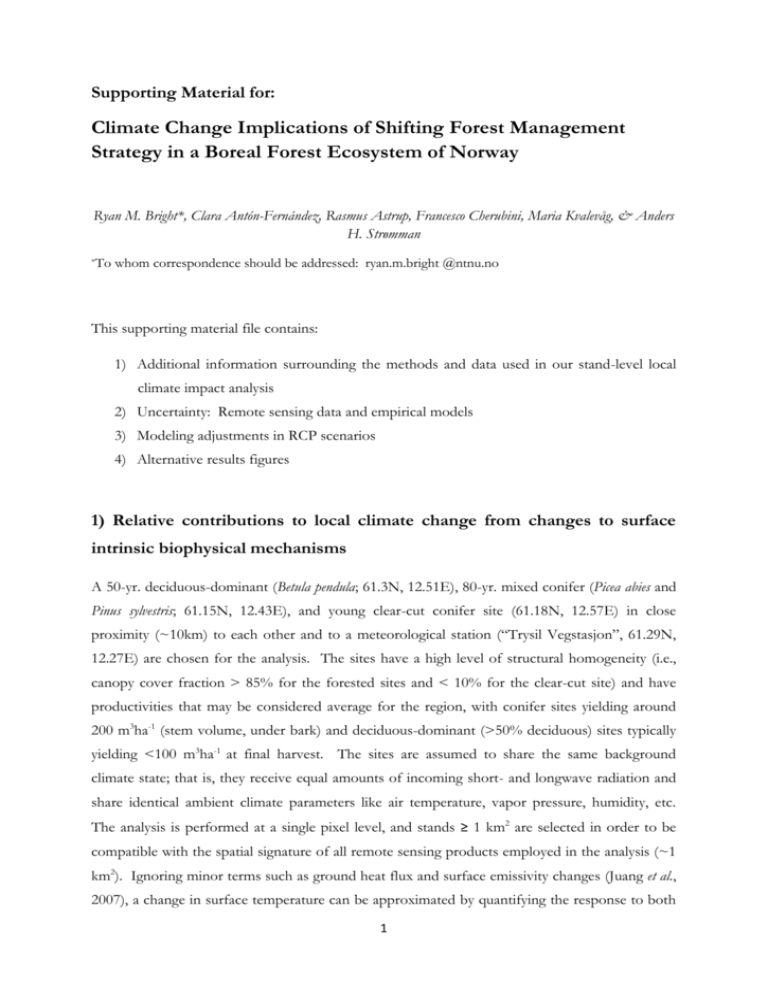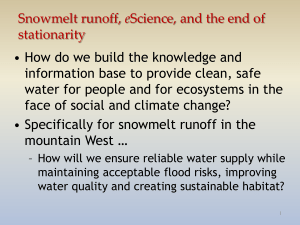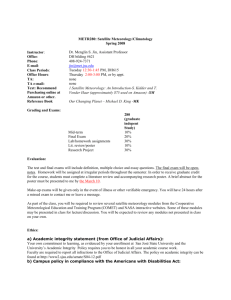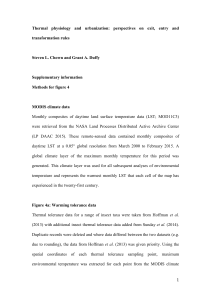gcb12451-sup-BrightetalGCBSIcorrectedproof
advertisement

Supporting Material for: Climate Change Implications of Shifting Forest Management Strategy in a Boreal Forest Ecosystem of Norway Ryan M. Bright*, Clara Antón-Fernández, Rasmus Astrup, Francesco Cherubini, Maria Kvalevåg, & Anders H. Strømman *To whom correspondence should be addressed: ryan.m.bright @ntnu.no This supporting material file contains: 1) Additional information surrounding the methods and data used in our stand-level local climate impact analysis 2) Uncertainty: Remote sensing data and empirical models 3) Modeling adjustments in RCP scenarios 4) Alternative results figures 1) Relative contributions to local climate change from changes to surface intrinsic biophysical mechanisms A 50-yr. deciduous-dominant (Betula pendula; 61.3N, 12.51E), 80-yr. mixed conifer (Picea abies and Pinus sylvestris; 61.15N, 12.43E), and young clear-cut conifer site (61.18N, 12.57E) in close proximity (~10km) to each other and to a meteorological station (“Trysil Vegstasjon”, 61.29N, 12.27E) are chosen for the analysis. The sites have a high level of structural homogeneity (i.e., canopy cover fraction > 85% for the forested sites and < 10% for the clear-cut site) and have productivities that may be considered average for the region, with conifer sites yielding around 200 m3ha-1 (stem volume, under bark) and deciduous-dominant (>50% deciduous) sites typically yielding <100 m3ha-1 at final harvest. The sites are assumed to share the same background climate state; that is, they receive equal amounts of incoming short- and longwave radiation and share identical ambient climate parameters like air temperature, vapor pressure, humidity, etc. The analysis is performed at a single pixel level, and stands ≥ 1 km2 are selected in order to be compatible with the spatial signature of all remote sensing products employed in the analysis (~1 km2). Ignoring minor terms such as ground heat flux and surface emissivity changes (Juang et al., 2007), a change in surface temperature can be approximated by quantifying the response to both 1 the external (albedo change) forcing and the efficiency with which net radiation is internally redistributed: Ts (1 f ) SW Rn f (1 f )2 (S1) where is the temperature sensitivity resulting from the longwave radiation feedback ( 1 / 4 Ts3 ), SW the net shortwave radiation change, Rn the apparent net radiation, and f the energy redistribution factor formulated by Lee et al. (2011): f C p 1 (1 ) 3 4 Ts ra (S2) where is air density, C p the specific heat of air at constant pressure, ra the aerodynamic resistance, the Stephan-Boltzmann constant, and the Bowen ratio -- or the ratio of sensible-to-latent heat flux. The change in the energy redistribution factor f (Eq. (S2)) can be decomposed into that associated with roughness changes f1 and changes to the Bowen ratio f 2 ( f f1 f 2 ): f1 C p 1 r (1 ) a 3 4 Ts ra ra (S3) f 2 C p 4 Ts3ra 2 (S4) where aerodynamic resistance ra is calculated using forest inventory, remote sensing and meteorological data (elaborated more below) and where the Bowen ratio is estimated with sensible heat flux as the residual of the surface energy balance equation ( Rn LE H G ): ( Rn LE G ) LE (S5) where LE is the latent heat flux from evaporation and transpiration estimated with an updated 8day MODIS global evapotranspiration algorithm (MOD16A2) (Mu et al., 2011), G the ground heat flux estimated using the Fraction of Absorbed Photosynthetically Active Radiation (FPAR) (MOD15A2) (Knyazikhin et al., 1999) as a surrogate for fractional vegetation coverage (Los et al., 2000), a soil heat flux ratio for a fully vegetated canopy of 0.05 (Monteith & Unsworth, 2008), 2 and a soil heat flux ratio for bare soil of 0.315 (Kustas & Daughtry, 1990). Net radiation Rn is the difference between incoming net shortwave radiation and outgoing net longwave radiation calculated following Allen et al. (1998) using daily insolation and clearness index data for our sites obtained from the NASA Langley Research Center POWER Project (NASA, 2013). Aerodynamic resistance ( ra ) to heat and momentum transfer is estimated for neutral conditions (stability parameters for heat and momentum equal zero) following refs. (Allen et al., 1998, Liu et al., 2007): ra 1 z d z d ln ln k 2 u z m z h (S6) where z is a reference height of 10 m, k is the von Karman constant ( 0.41), u the wind speed at reference height (ms-1) , d the zero-plane displacement height (m), or the height at which wind speed becomes essentially zero in the canopy, z m the roughness length for momentum transfer, and zh the roughness length for heat transfer. Roughness lengths for momentum z m and zeroplace displacement heights d are calculated using empirical models developed by Nakai et al. (2008) that are based on stand density SD (trees ha-1), LAI (m2 m-2), and mean tree height h (m): 1 exp(k1SD) 1 exp(k2 LAI ) d 1 h k SD k LAI 1 2 (S7) where k1 and k2 are parameters and LAI is leaf area index, also taken from MOD15A2 (Knyazikhin et al., 1999). For the deciduous site, a stand density of ~1400 trees ha-1 and average tree height of 9 m are used; for the conifer site, a stand density of ~750 trees ha -1 and average tree height of 15 m are used; the clear-cut site has a stand density of ~10 trees ha-1 (due to tree retention policy) with a mean tree height from 2004-2009 of 2 m. Roughness length for momentum is then estimated with the zero-plane displacement height, tree height, and an empirical constant: d zm 0.264(1 )h h (S8) Following Allen (1998) we assume the roughness length of heat, zh , is 1/10th of z m . 3 We take the diurnal mean radiometric surface temperature Ts from MODIS 1 km2 product 11A2 (Wan, 1999, Wan & Li, 2008) for use in estimating the climate sensitivity ( ) and energy redistribution expressions ( f ). MODIS 8-day Albedo/BRDF 1 km2 product MCD43B (Schaaf et al., 2002) provides estimates of black-sky shortwave broadband albedo and is used to compute changes in surface shortwave radiation ( SW ) and net radiation ( Rn ). Uncertainties surrounding the remote sensing products employed are discussed further in subsequent sections. The expanded form of Eq. (S1) is a reproduction of Eq. (2) in the main article, given as: Ts (1 f ) SW Rn f1 Rn f 2 2 (1 f ) (1 f ) 2 (S9) where the first, second, and third term on the right-hand side gives us the contributions to the surface temperature change from the albedo change forcing, roughness change, and Bowen ratio change, respectively. Figure S1 presents the 2004-2009 8-day means of the MODIS observations utilized in the Ts contribution analysis. The full LAI and albedo time series is presented in Figure S2 along with fractional vegetation coverage ( FC , used to estimate the ground heat fluxes, G), aerodynamic resistance ( ra ), roughness length ( z0 ), and Bowen ratio ( ) at each of the three sites. Table S1 provides an overview of how meteorological and remotely sensed data are utilized in the analysis together with their sources. 4 Table S1. Overview of meteorological and remote sensing variables employed in the standlevel/local impact analysis. Parameter ra Equation Eq. (S6) Name Aerodynamic Meteorological Variable Variable(s) Description u Windspeed at (Norwegian reference height Meteorological (ms-1) Institute, 2013) resistance Rn (Equation Net radiation not shown) K clr , Rs , VP, Clear-sky clearness Tair Data Source (NASA, 2013, index (unitless), Norwegian Downwelling solar Meteorological radiation at surface Institute, 2013) (Wm-2), Vapor pressure (kPa), Air temperature at reference height (K) Parameter Equation Name Remote Variable Sensing Description Data Source Variable(s) f Eq. (S2-4) Energy Ts redistribution Surface temperature (ORNL DAAC, (K) 2013) Fraction of (ORNL DAAC, 2013) expression FC (Eq. not Fractional shown) vegetation absorbed coverage photosynthetically FPAR active radiation Eq. (S5) Bowen ratio LE 5 Latent heat of (ORNL DAAC, vaporization (Wm-2) 2013) Figure S1. Six-year mean 8-day MODIS ET, Black-sky Albedo, LAI, and FPAR observations at each stand in our local-scale analysis, shown with standard deviation as indicator of inter-annual variability. Biophysical variables are grouped by color and row, and sites are grouped by column. Data are for a single MODIS pixel of ~1 km2. Six-year annual means and standard deviations are shown in legends. Differences in important radiative, aerodynamic, and physiological attributes across the three sites employed in the factor analysis are presented in Figure S2 for the full 2004-2009 time series. 6 Figure S2. Full six-year time series of key radiative, aerodynamic, and physiological parameters applied in the stand-scale local climate impact analysis. Top: Roughness lengths for momentum (left) and aerodynamic resistances to heat and momentum transfer (right); Middle: Black-sky albedo at local solar noon (left) and Bowen ratios (right); Bottom: Leaf Area Index (left) and Fractional Vegetation Coverage (right). 2) Uncertainty Remote sensing data Albedo products based on MODIS sensors have been thoroughly validated with field observations and other satellite data (Jin et al., 2003, Salomon et al., 2006, Tsvetsinskaya et al., 2006), with the accuracy of the Collection 5 shortwave albedo reported generally at <0.03 (Román et al., 2009, Wang et al., 2010). Only data passing quality control filters (Justice et al., 1998) were included in our analysis. For the remote sensing datasets, for any composite date having unacceptable data quality, values are filled by averaging values of acceptable quality from an 11-year time series at the same composite date, which has the benefit of constraining the local information provided by the interpolation with phenological and climatological information 7 included in the ensemble average (O'Halloran et al., 2012). Regarding albedo, this helps reduce interpolation errors from the discontinuities caused at the edges of snowy periods, where the albedo changes abruptly. Land surface temperature products from MODIS have a reported accuracy to within 1 degree C (0.5C in most cases) (Bosilovich, 2006, Wan & Li, 2008, Wang et al., 2008). Serbin et al. (2013) recently evaluated the spatial and temporal performance of MODIS LAI/FPAR over a boreal forest chronosequence in Manitoba, Canada, and found that MODIS LAI/FPAR Collection 5 generally outperformed the Collection 4 products when compared to insitu observations. For Collection 5 LAI, they report an uncertainty (RMSE) of 0.63 m2m-2, and for FPAR, they report an uncertainty (RMSE) of 0.07. Although in general the performance of MODIS LAI and FPAR (C5) products is good with respect to capturing the general phenological trajectory in boreal forests, Serbin et al. (2013) show that they tended to overestimate and underestimate the LAI and FPAR for the youngest (1 yr.) and oldest (154 yr.) sites, respectively. This implies that surface temperature contributions from aerodynamic roughness and Bowen ratio at our young/clear-cut site could be overestimated since computations are based on vegetation coverage fraction, aerodynamic resistance, and evapotranspiration (ET) – which all rely to some extent on MODIS LAI and FPAR (C5) products (MOD15A2). The recently updated MODIS 16 evapotranspiration (ET) algorithm of Mu et al. (2011) is applied in this study to estimate the latent heat ( LE ) flux at each of our sites, where results from AmeriFlux ground validation experiments show improvements over the old algorithm (Mu et al., 2007), with error ranges within the 10-30% mean acceptable range (Allen et al., 1998, Gowda et al., 2008, Kalma et al., 2008, Li et al., 2009, Wang & Dickinson, 2012). Although validation studies for boreal Norway do not exist, Velpuri et al. (2013) recently report good agreement between MODIS ET (MOD162) and in-situ ET for similar climate zones to those spanning our study region -- Koppen-Geiger “Dfb” and “Dfc” – with R2s of 0.72 and 0.59 and RMSEs of 31 and 25 (mm month-1), respectively. Empirical Models Parametric uncertainty in the models used to predict thinning and final biomass harvests, soil carbon, and albedo in each of the four forest management scenarios was not presented in the 8 main article (Figure 3). Figure S3 presents the Monte Carlo simulation mean outcomes after 1,000 runs (as shown in Figure 3) together with one standard deviation. Figure S3. Monte Carlo simulation mean (1,000 replications) NEE flux, HP flux, and surface albedo for each scenario shown with one standard deviation. 3) Modeling Adjustments: RCP Scenarios Radiative efficiency adjustments in emission Scenarios Carbon cycle-climate impacts presented in Figures 5 & 6 of the main manuscript are calculated using both a fixed radiative efficiency kCO2 based on the 2010 atmospheric CO2 concentration and one that evolves over time with the projected evolution of atmospheric CO2 concentration associated with RCP4.5 and 8.5 scenarios. Projected concentrations in these two scenarios are CMIP5 multi-model ensemble means (Meinshausen et al., 2011) which are fed into Eq.’s (7) and (8) of the main manuscript. Figure S4 shows the resulting values applied in the main article. 9 Figure S4. Radiative efficiency per kg CO2 emitted to the atmosphere for the two emission scenarios linked to representative concentration pathways (RCPs) 4.5 and 8.5 compared to the 2010 concentration of 389 ppm. 4) Alternative Figures: Results Local impact, full time series Figure S5 is an alternative version of Figure 2 of the main article that presents the full time series results from the local/stand-level analysis based, in part, on the data presented in Figure S2. 10 Figure S5. Full 6-year time series contributions to daily local surface temperature across three managed sites due to differences in surface albedo (“∆Albedo RF”), aerodynamic roughness (“∆Roughness”), and the partitioning of net radiation into sensible and latent turbulent heat fluxes (“∆Bowen”). A) Clear-cut site – Deciduous site; B) Clear-cut – Conifer site; C) Deciduous – Conifer forest. 11 Temperature-albedo feedback Figure S6 is an alternate version of Figure 4 of the main article showing absolute albedo trajectories rather than normalized. Figure S6. Simulation means of absolute spring and autumn albedo trajectories (lefthand y-axis, blue line colors) in the BAU scenario under projected regional climate warming (righthand y-axis, green line colors). References Allen RG, Pereira LS, Raes D, Smith M (1998) Crop evapotranspiration - Guidelines for computing crop water requirements - FAO irrigation and drainage paper 56. pp Page, Rome, Italy, UN. FAO. Bosilovich MG (2006) A comparison of MODIS land surface temperature with in situ observations. Geophysical Research Letters, 33, L20112. Gowda PH, Chavez JL, Colaizzi PD, Evett SR, Howell TA, Tolk JA (2008) ET mapping for agricultural water management: present status and challenges. Irrigation Science, 26, 223-297. Jin Y, Schaaf C, Woodcock CE et al. (2003) Consistency of MODIS surface bidirectional reflectance distribution function and albedo retrievals: 2. Validation. Journal of Geophysical Research, 108, 4159. Juang J-Y, Katul G, Siqueira M, Stoy P, Novick K (2007) Separating the effects of albedo from ecophysiological changes on surface temperature along a successional chronosequence in the southeastern United States. Geophysical Research Letters, 34, L21408. 12 Justice CO, Vermote E, Townshend JRG et al. (1998) The Moderate Resolution Imaging Spectroradiometer (MODIS): land remote sensing for global change research. Geoscience and Remote Sensing, IEEE Transactions on, 36, 1228-1249. Kalma JD, Mcvicar TR, Mccabe MF (2008) Estimating land surface evaporation: a review of methods using remotely sensed surface temperature data. Surveys in Geophysics, 29, 421-469. Knyazikhin Y, Glassy J, Privette JL et al. (1999) MODIS Leaf Area Index (LAI) and Fraction of Photosynthetically Active Radiation Absorbed by Vegetation (FPAR) Product (MOD15): Algorithm Theoretical Basis Document Version 4.0, http://eospso.gsfc.nasa.gov/atbd/modistables.html. pp Page. Kustas WP, Daughtry CST (1990) Estimation of the soil heat flux/net radiation ratio from spectral data. Agricultural and Forest Meteorology, 49, 205-223. Lee X, Goulden ML, Hollinger DY et al. (2011) Observed increase in local cooling effect of deforestation at higher latitudes. Nature, 479, 384-387. Li Z-L, Tang R, Wan Z et al. (2009) A review of current methodologies for regional evapotranspiration estimation from remotely sensed data. Sensors, 9, 3801-3853. Liu S, Lu L, Mao D, Jia L (2007) Evaluating parameterizations of aerodynamic resistance to heat transfer using field measurements. Hydrology and Earth System Sciences, 11, 769-783. Los SO, Pollack NH, Parris MT et al. (2000) A global 9-yr Biophysical Land Surface Dataset from NOAA AVHRR Data. Journal of Hydrometeorology, 1, 183-199. Meinshausen M, Smith SJ, Calvin K et al. (2011) The RCP greenhouse gas concentrations and their extensions from 1765 to 2300. Climatic Change, 109, 213-241. Monteith JL, Unsworth MH (eds) (2008) Principles of environmental physics, London, Elsevier Academic Press. Mu Q, Heinsch FA, Zhao M, Running SW (2007) Development of a global evapotranspiration algorithm based on MODIS and global meteorology data. Remote Sensing of Environment, 111, 519-536. Mu Q, Zhao M, Running SW (2011) Improvements to a MODIS global terrestrial evapotranspiration algorithm. Remote Sensing of Environment, 115, 1781-1800. Nakai T, Sumida A, Daikoku K et al. (2008) Parameterisation of aerodynamic roughness over boreal, cool- and warm-temperate forests. Agricultural and Forest Meteorology, 14, 1916-1925. Nasa (2013) Prediction of Worldwide Energy Resource (POWER). pp Page, NASA Langley Research Center. Accessed May 3, 2013 at: http://power.larc.nasa.gov/common/php/POWER_AboutPOWER.php. Norwegian Meteorological Institute (2013) eKlima - Monthly Historical Meteorology. pp Page, Norwegian Meteorological Institute. Accessed Jan 31, 2013 at: http://sharki.oslo.dnmi.no/portal/page?_pageid=73,39035,73_39049&_dad=portal&_schem a=PORTAL O'halloran TL, Law BE, Goulden ML et al. (2012) Radiative forcing of natural forest disturbances. Global Change Biology, 18, 555-565. Ornl Daac (2013) MODIS subsetted land products, Collection 5. Available online [http://daac.ornl.gov/MODIS/modis.html] from ORNL DAAC, Oak Ridge, Tennessee, USA. Accessed February 24, 2013. pp Page, Oak Ridge National Laboratory Distributed Active Archive Center (ORNL DAAC). Román MO, Schaaf CB, Woodcock CE et al. (2009) The MODIS (Collection V005) BRDF/albedo product: Assessment of spatial representativeness over forested landscapes. Remote Sensing of Environment, 113, 2476-2498. Salomon JG, Schaaf CB, Strahler AH, Gao F, Jin Y (2006) Validation of the MODIS Bidirectional Reflectance Distribution Function and Albedo Retrievals Using Combined Observations From the Aqua and Terra Platforms. IEEE Transactions on Geoscience and Remote Sensing, 44, 1555-1565. 13 Schaaf CB, Gao F, Strahler AH et al. (2002) First operational BRDF, albedo nadir reflectance products from MODIS. Remote Sensing of Environment, 83, 135-148. Serbin SP, Ahl DE, Gower ST (2013) Spatial and temporal validation of the MODIS LAI and FPAR products across a boreal forest wildfire chronosequence. Remote Sensing of Environment, 133, 71-84. Tsvetsinskaya EA, Schaaf CB, Gao F, Strahler AH, Dickinson RE (2006) Spatial and temporal variability in Moderate Resolution Imaging Spectroradiometer–derived surface albedo over global arid regions. Journal of Geophysical Research: Atmospheres, 111, D20106. Velpuri NM, Senay GB, Singh RK, Bohms S, Verdin JP (2013) A comprehensive evaluation of two MODIS evapotranspiration products over the conterminous United States: Using point and gridded FLUXNET and water balance ET. Remote Sensing of Environment, 139, 35-49. Wan Z (1999) MODIS Land-surface temperature algorithm theoretical basic document (LST ATBD) version 3.3. pp Page, Santa Barbara, Institute for Computational Earth System Science, University of California. Wan Z, Li Z-L (2008) Radiance-based validation of the V5 MODIS land-surface temperature product. International Journal of Remote Sensing, 29, 5373-5395. Wang K, Dickinson RE (2012) A review of global terrestrial evapotranspiration: observation, modeling, climatology, and climatic variability. Review of Geophysics, 50, RG2005. Wang K, Liang S, Schaaf CL, Strahler AH (2010) Evaluation of Moderate Resolution Imaging Spectroradiometer land surface visible and shortwave albedo products at FLUXNET sites. Journal of Geophysical Research: Atmospheres, 115, D17107. Wang W, Liang S, Meyers T (2008) Validating MODIS land surface temperature products using longterm nighttime ground measurements. Remote Sensing of Environment, 112, 623-635. 14



